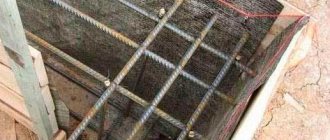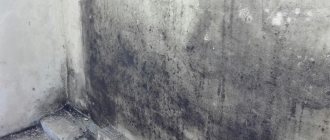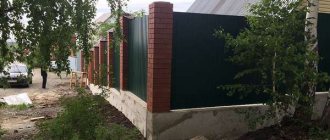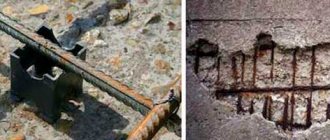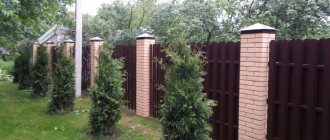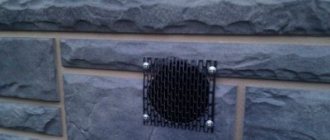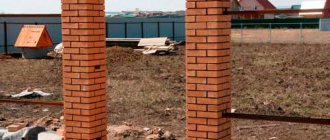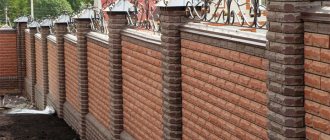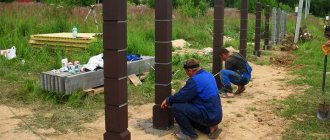The choice of the type of foundation for a fence depends on its purpose and the materials that are decided to be used in the construction. The main criterion is the weight of structures installed above ground level. A massive fence will require the use of a strong foundation. A lightweight fence will make the underground part of the structure lighter by choosing more compact solutions; it is easier to do it yourself.
Ready-made strip foundation for a corrugated fence
When constructing with brick or small-sized wall blocks, the developer has practically no other choice but a strip foundation. However, strip foundations can be used in other cases. When there is a need to completely separate the territory, without leaving any gap between the soil and the fence, then it will also be the most reasonable solution.
An example of such a choice would be a strip foundation for a fence made of mesh or corrugated board. Compared to pillars on separate foundations, a strip foundation is a more expensive and labor-intensive option. But it guarantees reliability and the maximum level of isolation.
Return to contents
Options for a strip foundation for a fence
Although the installation of such a foundation will not be cheap, in any case, there are options to reduce costs.
Diagram of a strip foundation for a fence
The foundation can be made in the form of a solid monolithic wall, the base of which is located at the level of soil freezing depth, and the upper cut extends to the design level above the relief level. A somewhat more economical method is to construct monolithic columnar foundations connected to each other by monolithic crossbars. The cost of such a foundation is lower.
The resistance of the structure to frost heaving is ensured by the depth of the columnar foundations.
Crossbars perform the function of foundation beams or grillage, distributing the weight of intermediate sections of the fence onto columnar foundations. They protect from frost heaving with a sand cushion and side sprinkling. In some cases, it is possible to use crossbars made of precast reinforced concrete, but this is rather an exotic option, used when there is an excess of suitable materials from the dismantling of other buildings.
Installation of a sand cushion under the foundation
The construction of almost any foundation for a fence can be done with your own hands.
Return to contents
Foundation
At the design stage, you need to consider the design of the foundation for a fence made of brick pillars. It must be present, in the minimum design - columnar. That is, brick columns must at least rest on and be connected to separate buried concrete supports. This, firstly, will make it impossible for them to tip over, and secondly, it will ensure support on stable ground. It is clear that the top layer, which constantly gets wet and freezes, is not like that.
When building on ordinary soil, the foundation under brick fence posts should be deepened 15–20 cm below the soil freezing depth typical for a given region (can be found in SNiP for construction climatology). If the soil, due to the absence of clay inclusions, has good drainage properties (sandy or rocky), a depth of 80 cm will be sufficient.
To make the support more stable, it can be made expanding downward. In this case, the linear size of the sole is doubled compared to the size of the upper platform, which is the base of the brick pillars for the fence. This technique will be especially appropriate in the case of columns intended for attaching a wicket or gate leaf.
If significant wind loads are expected or sections of the fence will have a relatively large weight, it is advisable to lay a shallow strip foundation 20–30 cm deep under them. For the sections attached to it, it will act as a reliable ballast, and in addition, it will connect the separate foundations for the pillars into a single structure.
Well, under a heavy stone or brick fence you need to build a strip foundation with full depth (below the freezing depth). Posts for a fence made of brick or stone are erected according to the same rules as for lighter canvases.
Having decided on the design of the foundation, it will not be difficult to calculate the volume of concrete required for its production.
Please note the following:
- All foundation elements should be placed on gravel or crushed stone pads 10–15 cm thick.
- A strip foundation must have a reinforcement cage inside.
- Concrete located in the ground must be protected from moisture with two layers of roofing material.
The connection between the fence post and the concrete support is ensured by a steel core that penetrates both elements. For this role, you need to prepare a pipe or 80th channel, sections of which will be welded in pairs into a box. The core must penetrate the foundation almost completely - here it also performs the function of reinforcement.
As for brick pillars, in those of them on which the wicket and gate will be attached, the core must reach the very top; in all other cases it can be 40–50 cm lower than the brickwork of the pillars.
Construction of formwork and pouring the foundation
The foundation is constructed according to the following scheme:
- A hole or trench (for a strip foundation) of sufficient depth is dug.
- Gravel or crushed stone is poured into the bottom and compacted thoroughly (layer thickness is 10–15 cm).
- Board formwork is installed, which needs to be sheathed from the inside with two layers of roofing material.
- A knitted reinforcement frame is installed in the formwork for a strip foundation, and for a foundation under brick columns, a steel pipe or other core is installed plumb to a vertical position. For more reliable fixation in concrete, the core can be equipped with a thrust bearing made of crossed corners or a plate.
- Concrete is poured into the formwork and into the core. If you decide to prepare it yourself, try to rent a small concrete mixer - the work will be much easier. Concrete can also be ordered from the reinforced concrete plant - it will be delivered by automixer. It is better to pour the foundation entirely in one approach.
Freshly poured concrete is pierced over the entire area with a shovel or reinforcement in order to remove air bubbles. After this, the structure is left to mature for 20–28 days, keeping it under polyethylene and periodically watering it with water. The formwork can be dismantled after 10 days.
In this case, you won’t have to bother with the formwork: this function will be performed by roofing material rolled into a box and inserted into the recess.
Materials for strip foundation
The choice of options is small. You can confidently use only monolithic concrete and rubble concrete. The same materials are used in the construction of any monolithic foundation for other purposes. Monolithic concrete will be more expensive, although more technologically advanced. Rubble concrete will allow you to use available resources in the form of local stone or large pebbles, the cost of which will be significantly lower, and also do some of the work yourself.
You can use brick debris from dismantling the walls. It should be taken into account that not all mineral resources should be used for backfilling. Recommended materials include granite and basalt. Softer types of stone, such as limestone or other chalk deposits, should not be used below ground level.
An example of a foundation for a natural stone fence
It is necessary to take into account that the rubble concrete base cannot be reinforced in a suitable manner. Therefore, if there are significant loads from the fence wall or weak soils with a high groundwater level, it is better to refrain from such a decision.
Return to contents
Width and depth of strip foundation
In general, a strip foundation for a fence should be slightly wider than the wall resting on it. For example, if a fence is built from bricks 25 centimeters long, then you need to settle on a foundation width of 0.3 meters. Using piece blocks 20 centimeters wide, the foundation should be made 0.25 meters wide.
When the fence has different thicknesses of elements, for example, pillars and adjacent fencing elements, then the width of the foundation will be determined in the same way, taking into account the different geometry. The marking of the load-bearing supports of the foundation or the entire strip at one laying depth cannot be less than the freezing level of the soil in your region.
Design diagram and dimensions of a monolithic strip foundation
You can find out the standard freezing depth in the regulatory documentation, for example, in SNiP 2.02.01-83*.
Return to contents
How to calculate the depth and width of a foundation trench
What do you need to know before starting construction? The main questions that will have to be resolved are:
- magnitude of vertical and horizontal loads;
- soil type;
- the presence of underground aquifers;
- find out the depth of soil freezing in the construction area.
Soil freezing map
Vertical load is the weight of building structures and materials located on the foundation. The calculation is made in tons/m2 based on the volumetric weight of the materials. For a brick fence, the weight of one brick (approximately 4.5 kg) is taken into account and multiplied by their number. Vertical load is directly related to the bearing capacity of the soil and is measured in kg/cm2. Having the total load on the foundation, in tons per square meter, it is not difficult to find out how many kg/cm2 falls in each specific case. To do this, you need to divide the load by area in cm2.
Horizontal loads can arise from strong cross winds or from hanging heavy metal gates.
To determine the type of soil, you need to dig a hole to the freezing depth and look at its structure. The pit will give a general idea of the presence of aquifers on the site and the level of underground groundwater.
Find out the amount of soil freezing from any construction organization conducting construction work in your area. How to calculate the freezing depth, see SNiP 23-01-99*.
If groundwater comes high to the surface, a drainage layer of crushed stone or gravel 200 mm thick must be made at the bottom of the trench.
Application of monolithic concrete
The most expensive and technologically advanced way to build a strip foundation is to use monolithic concrete. At the same time, all technological methods and the sequence of work do not differ from those used in most other cases, creating the same structures. The grade of concrete is selected depending on the loads. The load on the base is determined by the choice of material for the fence wall and its height.
A massive fence with brick walls made of ceramic or silicate material will require the use of B25 concrete. If you decide to use a lighter material or limit yourself to a small height, then you can use concrete grade B20, which costs less. In this case, it is necessary to comply with all requirements for laying concrete. Work must be carried out in the warm season, avoiding freezing of the base and concrete mixture.
An example of a massive concrete foundation for a brick fence
The use of frost-resistant additives for concrete is possible, but they pose certain risks. Additives will allow the mixture to be laid, but positive temperatures are still needed to gain strength.
Concrete should be compacted thoroughly. This is done either by the bayonet method or using a vibrating mace. When bayoneting, use a piece of reinforcement with a diameter of 12 millimeters. When laying concrete mixture in hot weather, it is necessary to protect it from drying out. To do this, a section of the monolithic structure is covered with plastic film and periodically irrigated with water for several days.
Return to contents
Application of rubble concrete
Rubble concrete has practically no technological differences when constructing structures from traditional monolithic concrete. The only difference is the larger aggregate, which is placed separately from the concrete mixture. Therefore, this type of foundation is preferred by those who like to build with their own hands.
The process of pouring a rubble foundation
The stone filling is laid out in rows up to 30 centimeters high and across the entire width of the foundation. After which the concrete mixture or sand-cement mortar is poured just above the backfill level.
It is very important to carefully fill all the voids between the stones with concrete. Sometimes the sequence of work is different. Backfill elements are embedded in a small layer of concrete or mortar, up to 15 centimeters high. The choice of techniques depends on the specific circumstances and size of the material. To settle the mixture and distribute it over the voids, you will only have to use bayoneting, since large rubble elements will interfere with the work of the vibrating mace. This reduces manufacturability and increases labor costs, but allows you to do the work yourself.
Care for freshly laid concrete is carried out in the same way as with a regular monolith. Either protection from freezing or irrigation with water during the setting period is required.
Diagram of a rubble foundation for a fence
Return to contents
Construction of a trench and soil foundation
The trench, or foundation pit, is made to a depth slightly greater than the bottom of the concrete. This requirement is due to the fact that the concrete structure must rest not on natural soil, but on a sand bedding 150 millimeters thick, which can be easily done with your own hands. It is made with medium-sized sand and compacted thoroughly.
It should be noted that the foundation soil should not lose its initial properties. That is, freezing, soaking and loosening of it is unacceptable. If such transformations occur, the disturbed soil layer is replaced with sand backfill of the required thickness with mandatory compaction. The width of the trench in the upper part is determined by the type of soil and the angle of its natural repose. At the base it will be 20–30 centimeters wider than the thickness of the foundation for the installation of a sand cushion and installation of formwork.
construction of a trench for pouring the foundation
In some cases, formwork for a rubble concrete foundation is optional. Construction is carried out by filling the trench with backfill and pouring the foundation with concrete mixture.
This option is possible in dense, hard and dry clay soils. But in general, formwork is necessary. After laying the foundation, the trench is filled with medium-sized sand with layer-by-layer compaction. The use of clay soils for this is highly undesirable. When wet and subsequent freezing, they can cause significant deforming and pushing forces that negatively affect the structure.
Return to contents
Features of the grillage device
The foundation for relatively lightweight structures can be made in the form of a grillage. In this case, the main supports on which the columns or fence posts are installed are poured to the freezing depth.
Drawing for installation of foundation grillage
Depending on the type of concreting used, they are made as a concrete or rubble concrete strip foundation. The section, made in the form of a crossbar or foundation beam, is laid to a depth of 0.5–0.75 meters.
Its sole is cast on a sand cushion 25–30 centimeters thick of compacted medium-sized sand. The element is filled with sand on the sides to a width of 15–20 centimeters; this work can be done with your own hands.
This solution allows you to distribute the weight over the main foundation supports, while protecting the grillage elements from frost heaving of the soil. The height of all foundation elements is set to the design elevation determined for this section of the fence. The grillage should not be made of rubble concrete, since it cannot be reinforced. Concreting of foundation elements of the same height should be carried out simultaneously for both the supporting part and the grillage.
An example of installing a foundation grillage for a fence
Return to contents
Reinforcement
The strip foundation for the fence works in quite difficult conditions. First of all, due to its length and due to the lack of transverse elements. Therefore, there is a high probability of cracks and deformations in the foundation, which can lead to destruction of the building envelope. Although this requirement cannot be considered mandatory, if there is an opportunity and desire, it is better to implement it.
The best option for reinforcement would be to install two belts of reinforcement with a diameter of 12 millimeters, with a step in the transverse direction of 100–150 millimeters. Longitudinal reinforcement should be tied every 30–40 centimeters with transverse rods. Reinforcement of the grillage is necessary both in the middle part, to absorb bending loads, and in places adjacent to columnar foundations.
Reinforcement should be calculated taking into account the load on the grillage. But the minimum requirement can be considered the use of three reinforcing bars with a diameter of 12 millimeters in the middle and lower sections and three rods of the same diameter about a meter long in the upper section, in the places where the grillage adjoins the buried part of the foundation.
When performing reinforcement with your own hands, do not forget the requirements for providing a protective layer of concrete. Its thickness from the outer edge of any concrete element to the outer surface of the reinforcement should not be less than five centimeters. The formwork of the element determines its outer edge; gaps are checked before concreting begins. During the process of pouring the foundation, if necessary, the installation of embedded elements is carried out.
Return to contents
Waterproofing
The foundation for a fence with brick pillars does not require coating waterproofing, unlike the foundations of buildings. Although if it is done, it will not be worse; the concrete will be less exposed to groundwater. But vertical waterproofing between the concrete base and brick or block wall elements must be done.
For it, you can use one or two layers of waterproofing, roofing felt or similar material. The choice is determined by the difference in their prices. Installation of waterproofing is carried out over a layer of bitumen mastic.
Return to contents
Creating a strip foundation - step-by-step diagram
Step 1: Trench
After the depth of the foundation is finally determined, you can prepare a foundation pit for pouring it. First of all, the fertile layer with grass and root system is removed. After removing the turf, we dig a trench; its parameters are taken from those calculated for the foundation. But you should take into account the presence of formwork in the future, so make the width with a margin of about 10 cm so that you can easily install plywood walls on both sides.
Step 2: Pillow
When the trench is ready, the foundation is laid. As a rule, after removing the soil, a cushion is filled in, which includes crushed stone with sand (or without sand). A special tamping machine is used for compaction. Next we make a sand cushion, after which it is compacted using a wet method (watered abundantly with water, which then seeps further into the ground). In some cases, the cushion after compaction can be spilled using liquid cement laitance.
A lot depends on the base and cushion, in particular, the uniform settlement of the strip foundation. Therefore, layers of sand and crushed stone can be alternated with the obligatory tamping and spilling with water.
Step 3: Formwork
After the trench for the strip foundation is ready, the next stage of work will be the assembly of the formwork. In most cases, formwork is made from boards, which must be planed on one side and have a thickness of approximately 40 or 50 millimeters. If possible, use large panels of plywood; this is more convenient. The finished formwork panels are installed inside the trench. For very financially free owners, we can also recommend metal panel collapsible formwork. During installation, wooden formwork must be cleared of shavings and debris and firmly fixed to the walls of the trench using spacers. The surface of the formwork must be moistened generously with water. The verticality of the walls is checked with a plumb line. The formwork is installed 30 cm above ground level. If necessary, technological holes are left for water supply and sewerage pipes.
Step 4: Reinforcement
During the installation of the formwork, reinforcement is installed around the entire perimeter; the easiest way is to organize several frame sheets. They can be made by welding or wire binding. This should be a mesh with a cell, the side of which will be at least 20 cm. Usually, two rows of such a mesh are enough, which are installed in the trench at such a distance from each other to be evenly spaced in width. They are fastened into a single three-dimensional frame with horizontal reinforcement bars.
Step 5: Concreting
After the reinforcement is poured with concrete, a monolithic reinforced concrete strip foundation structure with high strength characteristics is obtained. Concrete is poured in small layers, the thickness of which is approximately 15-20 centimeters. Each layer must be compacted using special wooden tampers or tapping the formwork walls. The ideal option is to use a concrete vibrator. The consistency of the concrete should be the same and not separate into layers. If the concrete is too liquid, all the filler will simply settle to the bottom. Special chutes or other similar devices must be used for pouring.
Step 6: Insulation
The formwork is removed after approximately 7-10 days, when the concrete strength reaches 70% of the standard. After this, waterproofing is installed to prevent moisture from entering the fence walls. For its installation, bitumen mastics and waterproofing materials are used. In most cases, roofing felt is used as the most effective and cheapest material. After the waterproofing has been installed, it is necessary to backfill the foundation sinuses. For this operation, take sand of medium consistency, which is carefully compacted so as not to damage the waterproofing, and spilled with water. The concrete gains standard strength within 28 days, after which the remaining elements of the fence can be installed.
- Author: Manager Andrey
Rate this article:
- 5
- 4
- 3
- 2
- 1
(2 votes, average: 3 out of 5)
Share with your friends!
Fence formwork
When building a fence around a site with your own hands or with the help of hired specialists, you need to understand how the necessary work is performed correctly. Let's consider the question of how to make formwork for a fence.
Ready formwork for pouring the foundation
Return to contents
Why is it needed?
Even a relatively light fence made of profile pipes and sheet materials needs a foundation. The appearance of the fence, its verticality and correct geometry depend on how securely it is fixed in the ground. A rickety fence costing several tens of thousands of rubles will daily spoil the mood of the owner who has decided to save a couple of thousand on the foundation.
The fence is affected by wind loads, which are transmitted to the foundations through the pillars. But soil movements as a result of precipitation and frost heaving have a greater influence. Even slight tilts cause visible displacement of the pillars and can lead to cracks in the brick elements of the fence. Therefore, the fence is placed on a reliable foundation.
It is usually made from monolithic concrete. This is not a very difficult, although labor-intensive job, which many people try to do with their own hands to save money.
This is what concrete poured into formwork looks like
A concrete monolith requires formwork, which shapes its future geometry.
Return to contents
Formwork materials
The choice of materials from which formwork can be made is almost unlimited. The list can begin with special waterproof plywood and end with a mention of construction waste in the form of pieces of boards and tin, which all those who like to build with their own hands know about. The choice is influenced only by the preferences of the developer. However, free things are not always rational.
For formworks, an important economic criterion is the number of turnover cycles. Therefore, if a rotten slab can be used for some one-time work, then for repeated reproduction of a standard element it is more profitable to use even imported waterproof plywood. The typical choice of professionals are three materials:
- Edged board about thirty millimeters thick;
- Waterproof plywood with a thickness of one centimeter;
- OSB wood board with a thickness of one centimeter.
In addition to the materials that will form the outer surface of the monolithic product, a certain amount of timber will be required to strengthen the vertical walls and make supports. For this, material with a cross-section of three to five centimeters is sufficient.
Return to contents
How and where is it installed?
The formwork will determine the geometry of your foundation. Therefore, it is installed strictly where this foundation should be located not only in plan, but also in height. It is necessary to take into account the property of concrete to shrink during setting and the need to settle the concrete mixture by vibrating or bayoneting at the time of laying. Accordingly, the height of the formwork should be three to five centimeters higher than the design level of the concrete.
The formwork is mounted on a prepared base for the fence, that is, in a prepared trench or pit. The bottom of the trench is made fifteen centimeters below the design mark of the foundation base. This gap should be filled with carefully compacted medium-sized sand to the design level.
The width of the bottom of the trench or foundation pit for the pillars should be 15–20 centimeters wider than the formwork. This is necessary in order to be able to securely fasten the formwork from the outside.
Return to contents
Fastening the formwork
When pouring concrete and vibrating, significant displacement and deforming forces occur. They are especially large when using mechanisms for supplying large volumes of concrete mixture. Therefore, if mechanical rather than manual laying of concrete is intended for pouring the foundation, securing the formwork in the design position should be done with the utmost care.
Scheme of fastening the foundation formwork
The height of the formwork will be equal to the freezing depth, plus the base protruding above the relief. For most regions of Russia this will be one and a half meters and above. Displacement of the lower edges of the formwork is prevented by anchoring with wooden pegs driven to a sufficient depth.
If the formwork is installed to pour a strip foundation, then it is necessary to strengthen the entire length of the section prepared for pouring with the help of spacers. It is recommended to fix spacers not only on top of the formwork, but also in the middle section. They are usually installed at an angle of 45 degrees and supported in driven pegs or directly into the wall of a pit or trench.
When securing the formwork of individual foundations for fence posts, follow the same rules. But fastenings are placed along the entire perimeter of the formwork. This stage of work is not difficult, although it is responsible, so even a novice builder can do it with his own hands.
Return to contents
Fixation of formwork geometry
The concrete mixture weighs over two tons per cubic meter. This is a very heavy material that has the properties of a liquid before setting. Therefore, the pressure in the lower plane of the cross-section of the volume being filled will be very high. It tends to squeeze the formwork walls outward, which leads to deformation of not only the strip foundation, but also the bases for the pillars. In addition to geometry violations, this also causes excessive consumption of concrete. When constructing formwork, one should strive to reduce such deformations.
Although it will not be possible to completely avoid them when building with your own hands, since this requires special inventory formwork.
Fixing the geometry is required not only to prevent the formwork from expanding outward, but also to control the internal dimensions. The simplest way to prevent the formwork from bursting is to install twisted wires at some distance.
It depends on the rigidity of the formwork material and the height of the concrete layer being poured. It is recommended to place twists every one and a half, two meters in length and about half a meter in height. The number of tiers of twists depends on the height of the formwork. To ensure the required internal dimensions, bars with a length equal to the width of the foundation are installed.
Thus, the formwork for the foundation under the fence is rigidly fixed from compression by twists or spacers using bars, and from bursting with concrete when pouring - by means of twists. In addition to twists and spacers, which you can easily make with your own hands, there are professional sets of fixing elements for formwork, available for purchase in the retail chain.
Return to contents
Reinforcement
The formwork of a strip or columnar foundation for a fence allows you to install and secure the lower reinforced belt.
Option for reinforcing the corner part of the foundation in formwork
When reinforcing, the dimensions of the protective layer of concrete should be observed. It should not be less than five centimeters in any direction. The reinforcement is laid on pads resting on the ground.
The height of the spacers must provide the required clearance. The distance from the inner edge of the formwork to the outer surface of the reinforcement should also not be less than the thickness of the protective layer of concrete. When reinforcing pillar foundations, it is necessary to control gaps in both longitudinal and transverse directions. When installing reinforcing bars, mesh or frames, you can also use plastic elements specially made for this purpose, which can be purchased at building materials stores.
Return to contents
Concrete pouring and turnover
Before concreting, it is advisable to treat the inside of the formwork with a composition that reduces the adhesion of concrete to the material from which it is made. To do this, you can use special impregnations or used machine oil.
The main task when feeding concrete into the formwork is to maintain its design position. There is no need to rush to get the job done faster. Concrete must be supplied in layers up to half a meter high. After pouring the concrete, it should be compacted using a vibrating mace or using the bayonet method, making sure that the material completely fills the entire area of the formwork.
The process of pouring a foundation for a concrete fence
After some time, sufficient for the concrete monolith to set and gain initial strength, the formwork is carefully dismantled. It can now be used to fill the next section of the strip or column foundation. Fence formwork can be wrapped multiple times, depending on the quality of the materials and the care taken in assembly and disassembly.
Do-it-yourself solid strip foundation for a fence
An ordinary tape is installed under the stone fence. How to do it right:
Dig a trench to the calculated depth below the freezing level
It is also important to maintain the correct width of the recess: it should be 15-20 cm larger than the future wall on each side for ease of work. The bottom is filled with 15-20 cm of sand and gravel mixture, after which it is thoroughly compacted. To be sure, the layer can be well shed with water - it will additionally compress the pillow to working condition. Preparing the formwork
Its design depends on the size and type of base chosen. The boards are nailed together with vertical jumpers into a single wall. Place it on the bottom of the trench and secure it with additionally installed wooden posts for rigidity. For high formwork, additional reinforcement is made at the top: the sides are connected in pairs with boards. The pitch of vertical supports should not exceed 1-1.5 meters. The frame is being prepared. The longitudinal rods are positioned in such a way that there is a margin of 3-4 cm to the edges of the structure to protect the reinforcement. For a base for a fence, 2 rods per plane are enough. The height of the frame can be arbitrary; it is optimal to take a step between the longitudinal reinforcement of 200-300 mm. Dressing is carried out with clamps 6 mm in diameter, the step between them can be 200-250 mm. The finished frame is laid at the bottom of the trench on small bars 4-5 cm high - they are necessary to protect the reinforcement with concrete on the pillow side. If vertical pipe supports are needed, they are installed after reinforcement, driven to a depth of 0.5-1.0 meters (a kind of pile is obtained) and leveled in height. The next stage is pouring a strip foundation under the fence. It is advisable to carry out the process at once so that the concrete does not set in separate sections. Laying the solution begins from any corner, gradually filling the entire volume, compacting the mixture with vibrators or a shovel. If it happens that there is not enough concrete for the entire volume, before subsequent pouring, the set layer must be chiseled to create a relief surface, thoroughly moisten it and only then continue laying. But it is better to avoid such a situation - unevenly hardened concrete will not work as a single whole.


